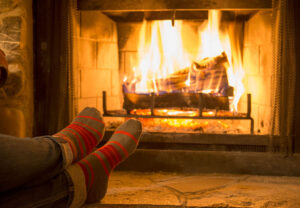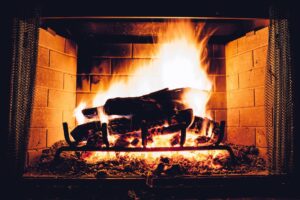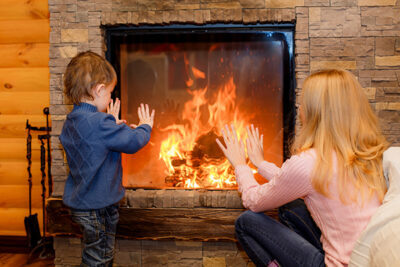A fireplace is a warm and welcoming feature in any home, providing both ambiance and heat during the colder months. But just how hot does a fireplace get? The answer to this question depends on several factors, including the type of fireplace, the fuel being used, and the efficiency of the fireplace.
Wood-burning fireplaces can reach temperatures of up to 1,100 degrees Fahrenheit or more, while gas fireplaces tend to be cooler, reaching temperatures of around 400 degrees Fahrenheit.
However, it is important to note that the actual temperature inside the fireplace itself may be much hotter, as the heat is being released into the room rather than being contained within the fireplace.
Regardless of the type of fireplace, it is important to use caution when approaching a lit fireplace and to follow all safety guidelines to prevent accidents or injuries.
How hot does a fireplace get?

The temperature of a fireplace can vary greatly depending on a number of factors, including the type of fireplace, the fuel being used, and the efficiency of the fireplace.
Wood-burning fireplaces tend to get much hotter than gas fireplaces. When a wood fire is burning at its hottest, it can reach temperatures of up to 1,100 degrees Fahrenheit or more.
The temperature inside the fireplace itself may be even higher, as the heat is being released into the room rather than being contained within the fireplace. The temperature of a wood-burning fireplace can also vary depending on the type of wood being burned and the size of the fire.
Gas fireplaces, on the other hand, tend to be cooler, with temperatures ranging from around 200 to 400 degrees Fahrenheit. The temperature of a gas fireplace can also be controlled using a thermostat, allowing you to adjust the heat output to your desired level.
The temperature of a fireplace can fluctuate based on how it is utilized and how well it is maintained. By taking care of the fireplace and using it correctly, the efficiency of the fireplace can be improved, leading to a safe and comfortable temperature.
How hot does a traditional wood-burning fireplace get?
The temperature of a traditional wood-burning fireplace can vary greatly depending on a number of factors, such as the size of the fireplace, the type of wood being burned, and the rate at which the wood is being burned.
In general, a wood-burning fireplace can reach temperatures of 500 to 1,500 degrees Fahrenheit or more when burning at its peak. However, the temperature of the fireplace will decrease as the fire burns down, and the temperature at the front of the fireplace where the heat is being radiated will be significantly cooler than the temperature of the fire itself.
Can a gas fireplace get as hot as a wood-burning fireplace?
In general, a gas fireplace will not get as hot as a wood-burning fireplace. This is because a gas fireplace operates by burning gas rather than wood, and gas burns at a lower temperature than wood.
The maximum temperature that a gas fireplace can reach will depend on the specific model of the fireplace and the type of gas that it is designed to burn, but it will typically be significantly lower than the temperature reached by a wood-burning fireplace.
There are several reasons for this difference in temperature. One reason is that the process of burning wood releases more energy than the process of burning gas, which results in a higher temperature. Additionally, wood-burning fireplaces typically have a more open design that allows for more oxygen to reach the fire, which can also contribute to a higher temperature.
In contrast, gas fireplaces are typically more sealed and have a more controlled burn, which can help to prevent the fire from getting too hot.
How to measure the temperature of a fireplace?

There are a few different ways that you can measure the temperature of a fireplace:
1. Use a thermometer
You can use a thermometer designed for high temperatures, such as an infrared thermometer or a thermocouple, to measure the temperature of the fireplace. These types of thermometers can be pointed at the fireplace from a distance to measure the temperature of the fire or the surrounding surfaces.
2. Use a thermocouple probe
If you have a gas fireplace, you can use a thermocouple probe to measure the temperature of the flame. The probe can be inserted into the flame and will give you a reading of the temperature of the flame.
3. Use a heat gun
A heat gun is a tool that uses a stream of hot air to measure the temperature of an object. You can use a heat gun to measure the temperature of the fireplace by pointing the gun at the fireplace and taking a reading from the gun’s display.
4. Use a pyrometer
A pyrometer is a specialized tool that is used to measure the temperature of extremely hot objects, such as those found in a fireplace. Pyrometers can be used to measure the temperature of the fire itself or the temperature of the surrounding surfaces.
What are the dangers of a fireplace getting too hot?
Fireplaces are a popular feature in many homes, providing a warm and cozy atmosphere on cold winter nights. However, it is important to ensure that a fireplace does not get too hot, as this can pose several dangers.
Some of the potential dangers of a fireplace getting too hot include the following:
1. Increased risk of fire: If a fireplace gets too hot, it can ignite nearby materials such as curtains, carpets, and furniture. This can lead to a dangerous and potentially deadly house fire.
2. Damage to the chimney: Extreme heat can damage the chimney or flue, potentially causing it to crack or crumble. This can lead to costly repairs and create a safety hazard if the chimney is not properly maintained.
3. Harm to people and pets: A fireplace that is too hot can cause burns to people and pets who come into contact with it. It is important to keep a safe distance from the fireplace and to use caution when using it.
4. Damage to the fireplace itself: Excessive heat can also damage the fireplace itself, potentially leading to structural problems or the need for costly repairs.
It is important to follow proper safety guidelines when using a fireplace to ensure that it does not get too hot and cause any of these potential dangers. This includes regularly cleaning and maintaining the fireplace, using a fireplace screen to prevent embers from escaping, and never leaving a fire unattended.
How to prevent a fireplace from getting too hot?
Preventing a fireplace from getting too hot is important in order to avoid the potential dangers that I mentioned earlier.
Here are a few steps you can take to prevent your fireplace from overheating:
1. Use dry, well-seasoned wood
Wet or green wood can produce a lot of smoke, which can cause the fireplace to get too hot. Using dry, well-seasoned wood will burn more efficiently and produce less smoke, helping to prevent the fireplace from overheating.
2. Keep the damper open
The damper is a flap that controls the flow of air in and out of the fireplace. When the damper is open, it allows the smoke to escape up the chimney, which helps to prevent the fireplace from getting too hot.
3. Use a fireplace screen
A fireplace screen can help to prevent embers from escaping the fireplace and igniting nearby materials. This can help to prevent a fire from starting and also help to reduce the overall heat of the fireplace.
4. Regularly clean and maintain the fireplace
Regularly cleaning and maintaining the fireplace can help to prevent it from getting too hot. This includes removing ashes, cleaning the chimney, and making sure that the fireplace is in good repair.
By following these steps, you can help to prevent your fireplace from getting too hot and ensure that it is safe to use.
What is the maximum temperature a fireplace can reach?
The maximum temperature that a fireplace can reach will depend on a number of factors, including the type of fireplace, the fuel being used, and the size of the fire. However, in general, a fireplace can reach temperatures of up to 1,200 degrees Fahrenheit or higher.
It is important to note that a fireplace should not be allowed to reach these extreme temperatures on a regular basis, as it can lead to damage to the fireplace and the surrounding structure, as well as an increased risk of fire.
In order to prevent a fireplace from getting too hot, it is important to follow proper safety guidelines, such as using dry, well-seasoned wood, keeping the damper open, and using a fireplace screen. Regular cleaning and maintenance can also help to prevent the fireplace from overheating.
Can a fireplace be too hot for a room?
Yes, a fireplace can be too hot for a room if it is not properly ventilated or if it is not used correctly. A fireplace that is too hot can cause the room to become uncomfortably warm and can also increase the risk of fire.
To prevent a fireplace from becoming too hot for a room, it is important to follow proper safety guidelines when using it. This includes using dry, well-seasoned wood, keeping the damper open to allow smoke to escape, and using a fireplace screen to prevent embers from escaping.
It is also important to ensure that the fireplace is properly ventilated, as this will help to dissipate the heat and prevent the room from becoming too warm.
If you find that your fireplace is making the room too hot, there are a few things you can do to help reduce the temperature. These include opening windows to allow for better ventilation, using a fan to circulate the air, and turning down the thermostat to reduce the overall heat in the room.
How does the size of a fireplace affect its temperature?
The size of a fireplace can affect its temperature in a number of ways. In general, a larger fireplace will be able to accommodate a larger fire, which can produce more heat. However, it is important to note that the size of the fireplace alone is not the only factor that determines the temperature.
The type of fuel being used and the ventilation of the fireplace are also important factors that can affect the temperature.
If a fireplace is too small for the size of the fire, it can become too hot, which can increase the risk of fire and damage to the fireplace and surrounding structure. On the other hand, if a fireplace is too large for the size of the fire, it can be difficult to generate enough heat to warm the room.
To ensure that a fireplace is operating at a safe and efficient temperature, it is important to follow proper safety guidelines and to maintain the fireplace regularly.
This includes using dry, well-seasoned wood, keeping the damper open to allow smoke to escape, and using a fireplace screen to prevent embers from escaping. It is also important to ensure that the fireplace is properly ventilated, as this will help to dissipate the heat and prevent the room from becoming too warm.
Can the temperature of a fireplace be controlled?
Yes, the temperature of a fireplace can be controlled to some extent by adjusting the size of the fire and the amount of ventilation. Here are a few ways you can control the temperature of your fireplace:
Use dry, well-seasoned wood: Using dry, well-seasoned wood will burn more efficiently and produce less smoke, which can help to prevent the fireplace from getting too hot.
Keep the damper open: The damper is a flap that controls the flow of air in and out of the fireplace. When the damper is open, it allows the smoke to escape up the chimney, which can help to prevent the fireplace from getting too hot.
Use a fireplace screen: A fireplace screen can help to prevent embers from escaping the fireplace and igniting nearby materials. This can help to prevent a fire from starting and also help to reduce the overall heat of the fireplace.
Adjust the size of the fire: The size of the fire can be adjusted by adding or removing wood as needed. A larger fire will produce more heat, while a smaller fire will produce less heat.
If you follow these steps, you can always help to control the temperature of your fireplace and ensure that it is operating safely and efficiently.
How does the type of fuel used in a fireplace affect its temperature?
The type of fuel that is used in a fireplace can affect the temperature of the fire in a few ways. One factor that can influence the temperature of the fire is the heat content of the fuel.
Different types of fuel have different amounts of heat energy that are released when they are burned, and this can affect the temperature of the fire. For example, wood has a higher heat content than natural gas, so a wood fire will typically be hotter than a natural gas fire.
Another factor that can influence the temperature of a fire is the rate at which the fuel burns. Some fuels, such as wood, burn relatively slowly and may produce a lower-temperature fire, while other fuels, such as propane, burn more quickly and can produce a hotter fire.
Finally, the type of fireplace and the way it is designed can also influence the temperature of the fire. For example, a fireplace with a good draft will typically burn hotter than one with a poor draft because a good draft allows more oxygen to reach the fire, which can increase the rate of combustion and raise the temperature.
What are the ideal temperature ranges for a fireplace?

The ideal temperature range for a fireplace will depend on the type of fireplace and its intended use. In general, a fireplace should be hot enough to provide sufficient warmth to the room but not so hot that it is uncomfortable to be near or poses a fire hazard.
For a wood-burning fireplace, the ideal temperature range is typically between 400 and 600 degrees Fahrenheit. At these temperatures, the fire will burn efficiently and provide a good amount of heat to the room.
For a gas fireplace, the ideal temperature range will depend on the type of gas that is being used and the design of the fireplace. Natural gas fires typically burn at lower temperatures than propane fires, so they may be more comfortable to be near. In general, the ideal temperature range for a gas fireplace is between 50 and 80 degrees Fahrenheit above the ambient room temperature.
It’s important to note that the temperature of a fireplace can vary widely depending on the type of fuel being used, the size of the fire, and the design of the fireplace. It’s always a good idea to use caution when working with fire and to follow the manufacturer’s recommendations for the proper use and maintenance of your fireplace.
How does the ventilation of a fireplace affect its temperature?
Ventilation in a fireplace can affect the temperature of the fire in a few ways. Proper ventilation is important for ensuring that the fire burns efficiently and at a safe temperature.
One way that ventilation can affect the temperature of a fire is by providing a good draft. A good draft allows air to flow into the fireplace, providing oxygen for the fire to burn. This can increase the rate of combustion and raise the temperature of the fire.
On the other hand, if the ventilation is poor and there is not enough oxygen flowing into the fireplace, the fire may burn less efficiently and at a lower temperature. In some cases, a poorly ventilated fireplace may produce too much smoke, which can be a fire hazard.
Finally, the type of ventilation that is used in a fireplace can also affect the temperature of the fire. For example, a fireplace with a chimney will typically have a better draft than one without a chimney because the chimney helps to create a natural updraft that draws air into the fireplace. This can help to increase the temperature of the fire.
Can a fireplace overheat and start a house fire?
Yes, it is possible for a fireplace to overheat and start a house fire. There are several factors that can contribute to the risk of a fireplace overheating and causing a fire, including the type of fuel being used, the size of the fire, and the design of the fireplace.
To prevent a fireplace from overheating and starting a house fire, it is important to follow the manufacturer’s recommendations for the proper use and maintenance of the fireplace. This may include:
- Using the appropriate type and size of fuel for the fireplace
- Building and maintaining the fire in accordance with the manufacturer’s instructions
- Keeping the area around the fireplace free of combustible materials
- Regularly inspecting and cleaning the fireplace and chimney to remove soot and creosote
- Using a fireplace screen to prevent sparks from escaping
It is also a good idea to install smoke alarms and a carbon monoxide detector in the home and to have the fireplace and chimney inspected and cleaned regularly by a professional. This can help to reduce the risk of a house fire caused by an overheated fireplace.
Conclusion
For safety reasons, it is important you know how hot does a fireplace get to prevent any fire hazard. Here on this page, you will get to learn more about fireplace heat, the safe temperature range, and some important safety caution you need to take.

